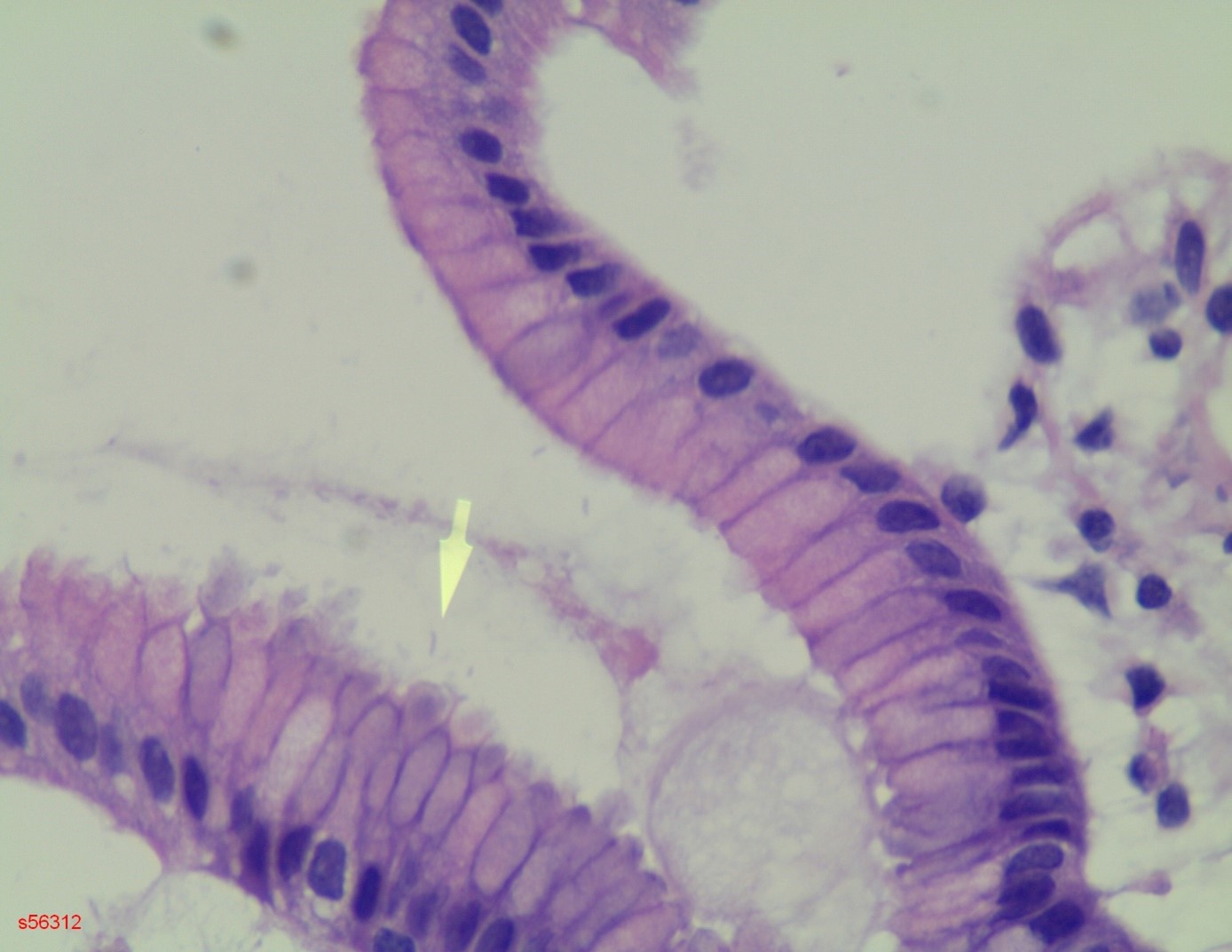Monday Poster Session
Category: Stomach and Spleen
From Farm to Antrum: <i>Helicobacter heilmannii</i>, a Zoonotic Cause of Peptic Ulcer Disease,
P4236 - From Farm to Antrum: Helicobacter heilmannii, a Zoonotic Cause of Peptic Ulcer Disease,
Monday, October 27, 2025
10:30 AM - 4:00 PM PDT
Location: Exhibit Hall
- CD
Chandra Dasari, MD
Orlando Health
Orlando, FL
Presenting Author(s)
Chandra Dasari, MD, Mikhail Ahmed, MD, Mahendran Jayaraj, MD
Orlando Health, Orlando, FL
Introduction: Helicobacter heilmannii mostly found in cats, dogs, and pigs is a rare cause of dyspepsia with a prevalence of less than 1% in western countries. Prevalence is higher in rural areas and has a zoonotic transmission. Clinical manifestations of Helicobacter species are much more severe when coinfected with Candida suggesting a synergistic effect. We describe the first documented severe clinical manifestations of H. Heilmannii and Candida albicans co-infection.
Case Description/
Methods: An 84-year-old male with a history of atrial fibrillation presented to the ED for unintended weight loss, anorexia, and epigastric abdominal pain for 4 months. He reports having worked on a farm for the first five decades of his life. Physical exam was remarkable for peri-umbilical tenderness. Labs showed mild leukocytosis. CT of the abdomen pelvis showed a patulous fluid-filled esophagus. EGD showed tortuous,dilated esophagus with diffuse white plaques. Non-bleeding superficial ulcers were found in the gastric body, incisura, and in the antrum. A severe post-ulcer deformity and a superficial duodenal ulcer (Forrest Class IIc) was found in the duodenal bulb. Biopsies of the lesions showed chronic active gastritis, gastric antral metaplasia without dysplasia, with immunohistochemical stain positive for helicobacter, with a morphology suggestive of Helicobacter heilmanni. Fungal culture from esophageal brushing revealed Candida albicans. The patient was prescribed fluconazole and triple therapy with outpatient follow up. Patient was symptom free with treatment.
Discussion: H. Heilmannii, like H. pylori is associated with peptic ulcer disease, gastric carcinoma, and gastric MALT lymphoma. Mainstay of diagnosis is endoscopic biopsy with histological examination. Silver stain or H&E, reveal gram negative, spiral shaped, “corkscrew” like rods, morphologically distinct to the shorter, curved rods of H. pylori. Reports suggest that Helicobacter pylori and Candida coinfection is associated with severe clinical manifestations such as gastric ulcerations with bleeding. There is a reported synergistic interaction in which candida shelters helicobacter leading to severe pathogenicity. Helicobacter heilmannii and Candida albicans co-infection is not reported in literature. This case elucidates the possibility of candida coinfection leading to increased pathogenicity of a less virulent helicobacter species such as helicobacter heilmannii which has possibly a zoonotic transmission.

Figure: Biopsy showing Helicobacter Heilmannii

Figure: Duodenal bulb ulcer
Disclosures:
Chandra Dasari indicated no relevant financial relationships.
Mikhail Ahmed indicated no relevant financial relationships.
Mahendran Jayaraj indicated no relevant financial relationships.
Chandra Dasari, MD, Mikhail Ahmed, MD, Mahendran Jayaraj, MD. P4236 - From Farm to Antrum: <i>Helicobacter heilmannii</i>, a Zoonotic Cause of Peptic Ulcer Disease,, ACG 2025 Annual Scientific Meeting Abstracts. Phoenix, AZ: American College of Gastroenterology.
Orlando Health, Orlando, FL
Introduction: Helicobacter heilmannii mostly found in cats, dogs, and pigs is a rare cause of dyspepsia with a prevalence of less than 1% in western countries. Prevalence is higher in rural areas and has a zoonotic transmission. Clinical manifestations of Helicobacter species are much more severe when coinfected with Candida suggesting a synergistic effect. We describe the first documented severe clinical manifestations of H. Heilmannii and Candida albicans co-infection.
Case Description/
Methods: An 84-year-old male with a history of atrial fibrillation presented to the ED for unintended weight loss, anorexia, and epigastric abdominal pain for 4 months. He reports having worked on a farm for the first five decades of his life. Physical exam was remarkable for peri-umbilical tenderness. Labs showed mild leukocytosis. CT of the abdomen pelvis showed a patulous fluid-filled esophagus. EGD showed tortuous,dilated esophagus with diffuse white plaques. Non-bleeding superficial ulcers were found in the gastric body, incisura, and in the antrum. A severe post-ulcer deformity and a superficial duodenal ulcer (Forrest Class IIc) was found in the duodenal bulb. Biopsies of the lesions showed chronic active gastritis, gastric antral metaplasia without dysplasia, with immunohistochemical stain positive for helicobacter, with a morphology suggestive of Helicobacter heilmanni. Fungal culture from esophageal brushing revealed Candida albicans. The patient was prescribed fluconazole and triple therapy with outpatient follow up. Patient was symptom free with treatment.
Discussion: H. Heilmannii, like H. pylori is associated with peptic ulcer disease, gastric carcinoma, and gastric MALT lymphoma. Mainstay of diagnosis is endoscopic biopsy with histological examination. Silver stain or H&E, reveal gram negative, spiral shaped, “corkscrew” like rods, morphologically distinct to the shorter, curved rods of H. pylori. Reports suggest that Helicobacter pylori and Candida coinfection is associated with severe clinical manifestations such as gastric ulcerations with bleeding. There is a reported synergistic interaction in which candida shelters helicobacter leading to severe pathogenicity. Helicobacter heilmannii and Candida albicans co-infection is not reported in literature. This case elucidates the possibility of candida coinfection leading to increased pathogenicity of a less virulent helicobacter species such as helicobacter heilmannii which has possibly a zoonotic transmission.

Figure: Biopsy showing Helicobacter Heilmannii

Figure: Duodenal bulb ulcer
Disclosures:
Chandra Dasari indicated no relevant financial relationships.
Mikhail Ahmed indicated no relevant financial relationships.
Mahendran Jayaraj indicated no relevant financial relationships.
Chandra Dasari, MD, Mikhail Ahmed, MD, Mahendran Jayaraj, MD. P4236 - From Farm to Antrum: <i>Helicobacter heilmannii</i>, a Zoonotic Cause of Peptic Ulcer Disease,, ACG 2025 Annual Scientific Meeting Abstracts. Phoenix, AZ: American College of Gastroenterology.
